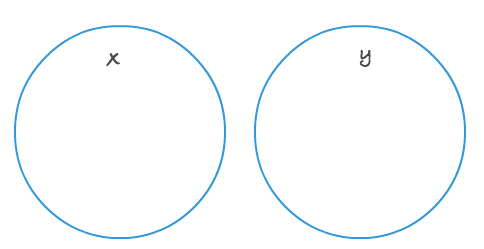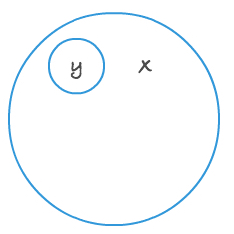Tidying doesn’t always come naturally to children, but sorting does.
r
Put a range of pictures or objects in front of them, and ask them to divide them into different groups, and they will generally get straight to work. It’s a simple and satisfying activity. They may spot categories that wouldn’t occur to us in a month of Sundays.
r
So, how can we use sorting activities to generate philosophical thinking? I’ve found myself talking about this in each of this week’s INSETs. Below are two ways to use a sorting activity to reach a philosophical question. Whilst the examples are my own, the ideas have been passed around for a number of years. I thank Roger Sutcliffe and Sue Lyle for passing them onto me.
r
1. Moving from simple sorting to contestable sorting
r
Take two skipping ropes or hoops and create a Venn diagram on the floor. This means you can easily demonstrate the idea of examples of x going here, and examples of y going there, with examples of both x and y in middle. For extra challenge, separate the circles and wait for someone to spot the need for a crossover space.
 r
rStart with something simple and visually verifiable. For example, dividing animals (resource here) by whether they live on land/sea. Give each child an animal so all can participate.
r
From here, gradually increase the challenge by moving from the factual to the contestable. For example, ask them to sort animals by good pets/bad pets. And finally, by which are OK to eat/not OK to eat?
r
We did this activity at St. Mary’s Academy in Middlesbrough on Friday, and we listened to teachers’ reasons for their choices. The group cited influences like intelligence, modern farming and how much we like the animal. I quickly scribbled down possible questions that could arise:
r
- Are more intelligent animals more valuable?
- Is it fair that some animals are born to die?
- Do we eat animals because we like them?
- Do other people decide which animals we eat?
These came from specific points, and serve as a good example of how you can reach a contestable, two-sided question from a simple and broad starting point.
r
2. Sorting using their own examples
r
Venn diagrams are also excellent for exploring how two concepts relate to each other by getting pupils to produce examples of each. I first did this with a Year 1 class whose topic was The Seaside. As always, we began simple by sorting a group of old postcards (buy a set on ebay) – seaside holidays in one circle, city holidays in another, and both.
r
A ‘crossing-over’ Venn diagram was probably suitable for these two similar concepts – school holidays spent at home aren’t trips, and school trips probably aren’t holidays (unless they involve stayingovernight, and are more fun than work). And there are probably plenty of examples that fall into both. Some concepts might have no crossover, so there will be no intersection in the Venn diagram. Do friends and enemies look like this…

r
…or is there a “frenemy” category where they overlap?
r
For some concepts, pupils might decide one is part of the other, meaning that examples of x are always examples of y, but there are some examples of y that aren’t x.

or vice versa!

r
Take pairs like these and ask your class how the circles should be drawn. Remember to always start by looking for examples of each.
- Beauty / Prettiness
- Thinking / Wondering
- Thoughts / Emotions
- Child-like / Childish
- Strong / Brave
- Happiness / Joy
- Alone / Lonely
- Living / Existing
What pairs of similar concepts sit within in your topics?
r
Best wishes,
r
Tom
r
PS: An advanced exercise is to get people to create a Venn diagram for a single concept using its constituent parts. Friendship analysed in terms of “people you…” like, trust, spend time with… makes for a challenging exercise. Jason had a lot of fun making one. Ask a philosopher a simple question…
r

r
This is one of our free P4C resources that can arrive direct to your inbox, every week. Just click that link to sign up!